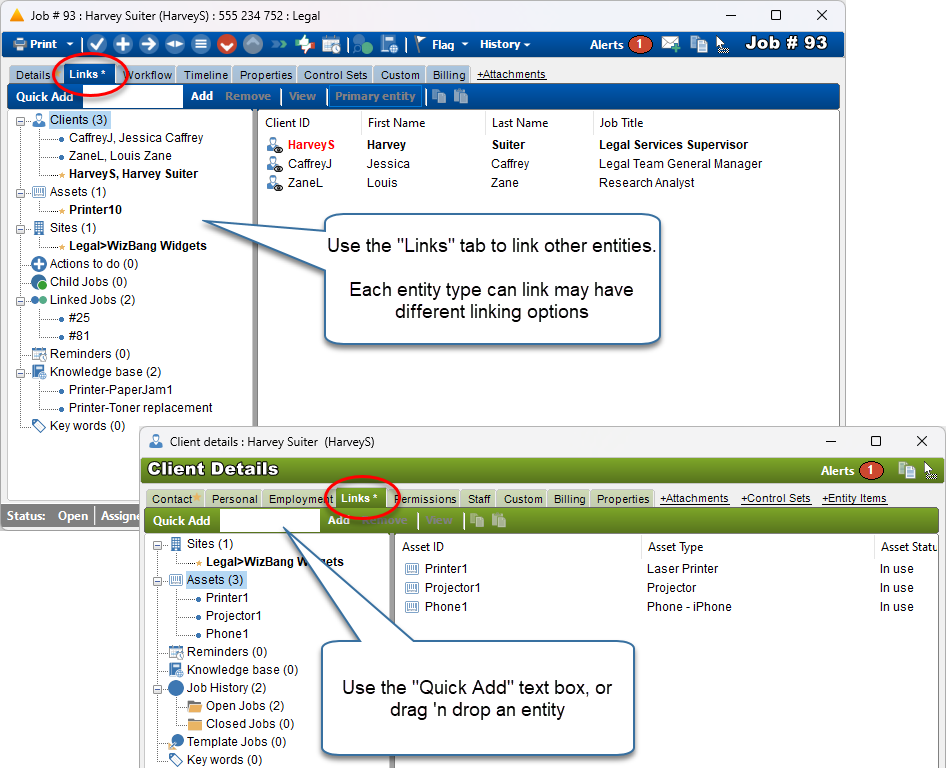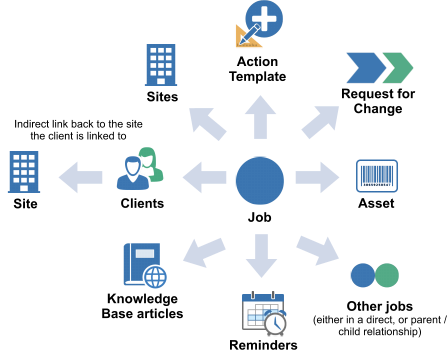Linking entities
One of the core concepts of HelpMaster is its ability to link each of the entities (clients, sites, assets, knowledge base articles, jobs, change requests etc) to each other. Linking entities to each other has the following benefits:
- Entity relationships are established
- Searching becomes more meaningful, richer and more powerful
- Reporting and statistics become more meaningful and powerful
- Staff and helpdesk agents have more complete information at their disposal
All links and entity relationships are displayed in the “Links” tab of each entity. Whenever an entity has something linking to it, an asterisk (*) will appear next to the Links tab caption.

Linking limits
In most circumstances, an unlimited number of entities can be linked to other entities. This means that you can have unlimited clients linked to one job, or unlimited assets linked to a client, etc.
Primary links
Sometimes when one entity type links to another, one of the linked entities can be nominated as the "Primary entity". Primary clients have a special meaning with helpdesk jobs. Although many clients many be linked to a single helpdesk job, only one of the clients is the primary client. This primary client can be sent unique email via the action screen. Primary clients are also used in reporting, searching and many of the options for the EmailManager, the PriorityManager and Triggered Events
Natural linking relationships
In general, most of the entities are able to link to every other entity. The list below describes the possible relationships.
Jobs
Jobs are one of the main entities within HelpMaster. As such, they can link to the most other entity types. The diagram below graphically represents some of these possible links.

Clients
- Clients can be linked to Jobs, with one client being nominated as the “Primary client”
- Clients can be linked to Sites, with one client being nominated as the “Primary client”
- Clients can be linked to Change Requests
Sites
- Sites can be linked to other sites to form a site hierarchy
- Sites can be linked to jobs
- Sites can be linked to Change Requests
Assets
- Assets can be linked to Jobs, with one asset being nominated as the “Primary asset”
- Assets can be linked to Sites, with one asset being nominated as the “Primary asset”
- Assets can be linked to Clients, with one asset being nominated as the “Primary asset”
- Assets can be linked to other Assets, with one asset being nominated as the “Primary asset”
- Assets can be linked to Change requests
Change Management - Request for Change
- Change Requests can be linked to Jobs
Knowledge base articles
- Knowledge base articles can link to Jobs, sites, clients and other knowledge base articles.
Derived or inferred linkages
Sometimes a link can be derived, or inferred. This means that an entity is related to another one, however not by a direct link. It is linked to another entity that is linked to the main entity. This relationship is similar to the way a grandparent is linked to their grandchildren, via the parents of the child.
For example:
When a client is linked to a site, and that client is then linked to a job, by association the site that the client is linked to can also be said to be “linked” to the job by derivation.
See also
Feedback
Was this page helpful?
Glad to hear it! Please tell us how we can improve.
Sorry to hear that. Please tell us how we can improve.